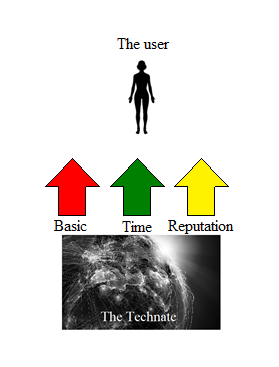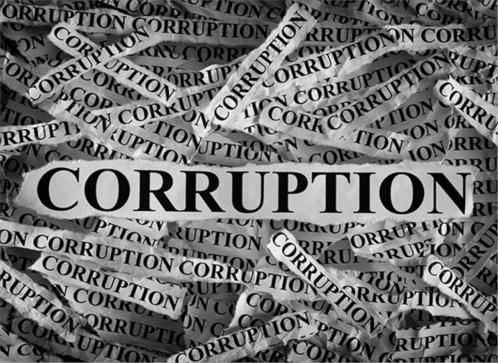Introduction
If the Design is proven to be a viable alternative to the current socio-economic system, and therefore is introduced, it would mean nothing less than a complete cultural and social transformation of the human civilization, and a shift of many values once considered essential and hailing back twelve thousand years.
Examples of concepts which would be altered would be ranging from trade and accumulation to inheritance, savings and interest. And these are the three factors we intend to showcase in this article, as we previously have discussed a lot about transactions under a technate, but considerably less about accumulation.
Primarily, the kind of civilization which will appear under the Design will not be characterized by the growing disparities of wealth and the conflation of wealth an influence characteristic of monetary market-based systems. This will not happen by any post-hoc regulations of political or other character, but rather – almost non-intentionally – be a consequence of the very structure of energy units, the currency of the future.
This transformation, if sudden, will be traumatic and cause social unrest. But, if the Design ever would be implemented, these aspects would be of integral character and would represent one of the most tangible and deepest transformations of global human culture ever occurring.
Thus, any implementation would have to be conducted as a gradual shift, and the nature of the transformation would have to be conducted in a manner of dialogue, inclusivity and transparency, to minimise the risk for toxic social strife.
Within the EOS, we are neither driven by passions for social justice, nor by the vice of vindictiveness. We are not deriving the Design from any Marxian tradition – our primary purpose is not to establish social equity, but to ensure that every human being on Earth can live a decent life within the sustainable ecological budget ceiling established by the physical reality of the planetary ecological economy.
Any such implementation undertaken haphazardly, covertly and under stress would certainly constitute a profound risk for a cultural and social collapse which will threaten the structural integrity of the human civilization, and risk ushering in a new dark age. That is why any implementation must happen with clear goals, delineations and democratic participation.
Notwithstanding our lack of socialist credentials, the successful implementation of the Design would lead to several outcomes which would create a more egalitarian and equitable human civilization, where wealth disparities not only would be smaller, but also of structurally fleeting character, making impossible the accumulation of land and wealth which previously has created the entrenched aristocracies of our world.
In return, social safety and prosperity will to a larger extent be derived from the individual share of the planetary resources allotted to each human being, on the virtue of – among other things – being a part of humanity.
TL;DR Summary
- Energy units are representing production capacity, not capital value derived from markets.
- It is physically impossible to use energy after it already has been converted to work.
- Expecting energy units to operate like money is unrealistic.
- Energy units are issued for a limited period and are thus susceptible to being deleted and replaced by new energy units issued for a second period.
- This will eliminate the concept of trans-period savings.
- When used, energy units will cease to exist.
- This will eliminate transactional trading.
- The intent of these design features are not to eliminate savings and transactions, but to allow energy units to correctly measure production capacity.
- If we would say that Energy Accounting was to be introduced, it would have to be introduced gradually – as it is so alien and different from the concepts of economics and human life we have come to expect as natural.

The nature of Energy Units as a currency
The reiteration of this cannot be stressed enough. While Energy Units, as envisioned by the EOS, are a currency, they are not money. There are important structural and philosophical differentiations which must be accounted for, with the structural taking precedence.
The first difference: Money has arisen gradually over three millennia, and represents a social safety net for the individual, indirectly at the expense of other individuals not immediately related. Organic money gave way to metal currency which gave way to fractional reserve banking and debt-based money, while there philosophically exists a perpetuation of an intellectually dishonest way of pretending that money is a law of nature.
As already Technocracy Inc. stated, the philosophical basis of money is the idea that scarcity is always unavoidable because of the limitlessness of human demand, one of the fundamental postulates of Orthodox and Neoclassical Economics. This is hardly surprising given that for the majority of money’s existence within human civilization occurred during a period where most of the work was dependent on raw human muscle power.
The expansion of capital in Europe from the 15th century and onward was driven by the development of credit mechanics, and this would lay the foundation for the first and second industrial revolutions. But these transformations in raw productive power and the transition to extraneous energy sources to supplant muscle power and vastly increase productive capacity also further transformed money into a hybrid system where the laws of scarcity still applies for the vast majority of the population not owning significant amounts of capital, whereas the large institutions and mega-corporations deemed “too big to fail” are existing in a parallel world, one where capital and credit could be attained by a limitless supply of debt, owed by the collective entity of the entire population. Currently, three units of debt are created for every unit of capital in the largest economies of the world.
More can be read about this topic in the article on this website titled: What is money and why is it problematic?
One frequent criticism from laypersons in regard to Energy Units is that they allegedly represent a more complex system. This I actually disagree with – in comparison to the hybrid systems currently employed, which are reliant on layer upon layer of misconceptions, vagueness, tradition and – arguably – omission of information, Energy Units are an incredibly simple concept.

The Energy Units are issued by the Technate through a process called Energy Accounting, where the entire size of the operational global economy (or at least technate-wide economy) within the limits of the Earth’s carrying capacity are routinely measured. When issued, they are distributed, to holons within the public sector and to all human individuals living within the total area of the Technate. When these entities are allocating their Energy Units, they de-facto allocate production capacity to specific operations. The cost in Energy Units for the production of an item or a service is equal to the cost (in energy terms) to extract the resources, manage the production and compensate for damage incurred on the environment. The cost will also take into account transportation costs and their environmental effects, thus creating incentives for local and greener production.
The Technate is issuing the Energy Units in packages of accounting periods, which are the estimates of the Earth’s production capacity within the planet’s ecological budget ceiling for a limited duration of time (the length of this period could range for x amounts of months or years). When a new accounting period begins, the old accounts – both on the public and private side – are thus reset, for a microsecond to zero and then to the measurement value for the new period. Thus, the specific global pool of Energy Units is for all purposes aimed to be of temporary character. This will, for quite obvious reasons, eliminate savings – thus preventing the long-term accumulation of capital.
Secondly, following the allocation of Energy Units to production and services, by the users (here we both account for human persons and public utilities), the Energy Units are transformed into information input and cease to exist as transferable currency. This means that for all ends and purposes, they cannot be used in the allocation cycle more than once. For obvious reasons, this will be simplified by the virtue of the Energy Units being an electronic currency. This will, also for quite obvious reasons, eliminate trade as we know it.

Why?
Why do we want to eliminate savings and trade?
Are we frothing-at-the-mouth anti-capitalists who simply hate success and freedom? Or do we see ourselves as radical revolutionaries fanatically intent to fight to end exploitation and build a new utopian future?
The answer is, neither of these latter postulates are true. We are not driven by any antipathy or sympathy for the capitalistic system, and neither primarily by egalitarianism or anti-hierarchical sentiments. We are, for all ends and purposes, pro-sustainability rather than anti-capitalism.
So, why do savings and exchange-based trade have to go?
The answer, of course, lies in preserving the structural integrity of Energy Units. They are not supposed to be money, and neither to be capital. Each individual specific pool of Energy Units are going to represent a share of the Earth’s renewal capacity, the global ecological budget we can use before we start to ramp up a deficit.
If we imagined that we made Energy Units transferable between entities, the process of tracking them would 1) become far more complex, and 2) they would no longer properly represent production capacity, and thus would be rendered useless in relation to the goal of keeping a global ecological budget ceiling.
If we imagined that we made Energy Units salvageable over extended durations of time exceeding the accounting periods of the Technate, that too would compromise the operative purpose of the entire system, unless we compensated for saved Energy Units by reducing the size of the remainder of the pool, thus making everyone else poorer.
Remember, the Technate represents a system where economic growth will be caused by technological development in terms of finding more efficient ways of managing energy, resources and production – thus while incomes may seem stagnant, at least over the short perspective, a process of continuous deflation will successively lower the costs of economic operations in the long perspective. The global ecological budget ceiling imposes, at least in terms of operations occurring on the planet and with planet-based resources, a limit to the kind of growth which sees areas converted from eco-systems to linear production systems.

Equality and egalitarianism
Especially the abolishment of capital accumulation will have specific effects on the society’s culture for a foreseeable future. Namely, self-perpetuating fortunes will be a thing of the past, and income differences will be vastly reduced. The Pareto distribution pyramid will be broken, meaning that no longer will 20% of the population have exclusive access to 80% of the total economic output. There will no longer be a 1%, and there will no longer be a 0,1%.
The primary social safety net will no longer be savings, but rather the fact that each human being will own a share of the planet’s renewal capacity for every year. What this will mean is that we will have one common bank for all of humanity – planet Earth.
So, maybe it is wrong to state that savings will be abolished – rather they will be transferred. With good stewardship, wise user choices (which under a regime of Energy Accounting will also be economically sensible) and technological progress, the individual accounts will grow for every passing period, thus representing savings which – contrary to our current situation – won’t decrease with spending, but will grow over an individual lifespan.
The model proposed by the EOS is a model of mixed accounts, where each individual human being will have no less than three accounts of Energy Units. These Energy Units will not be quintessentially different in any regard from one another, but will rather represent three distributive methods employed by the Technate.

- Basic distribution – each human being will receive a flat income of Energy Units comprising the basic needs of sustenance, housing, nutrition and recreation.
- Time-based distribution – every individual should be compensated the following accounting period for their work contribution in the current accounting period.
- Reputation-based distribution – the popularity of products and services in the different sequences (operational areas) of the Technate, no matter if the user is an individual, a community or a utility, can be used to distribute a boon to all individuals involved in the creation of said product and service.
With this system, the distribution of Energy Units will not be totally egalitarian no matter education, drive or incentives, and holons committing themselves to effective production and research will “outcompete” those holons which insist on doing a bare minimum of what is required. In short, teams committing themselves to contributing more for the wider community and the users will see their individual incomes rise in relation to those who contribute less.
Yet, despite this inequality of outcome, the system will be far more equitable over time as inequalities cannot sustain themselves longer than one accounting period, creating a greater degree of elasticity and preventing the emergence of a stratified society with a permanent class structure.

Moral hazards
The Design (which is the name of a system consisting of the triad of the Technate, the Energy Survey and the Energy Units currency) is a currently untested alternative to the current status quo. Thus, we will encounter challenges and problems when we expose it for field tests. Already now, before we’ve seen it operate, there are some areas where we can identify troubles arising.
Those areas are:
- The problem of incentives
- The problem of corruption
- The problem of bottlenecks
The problem of incentives can easily be formulated like this: “People will commit less to work under your system because they won’t be able to accumulate capital and build fortunes, which will mean that they will commit less in studying.” The extreme variation of this argument builds on the popular conception of human psychology which states that people will not work at all unless they are threatened by the Damocles sword of homelessness, starvation and death hanging over their heads.
One can say that this problem is the one which from our point of view is the least of a problem, at least from a theoretical perspective. The argumentation behind the problem is building on the idea that we need exponential economic growth – which is true under the current, debt-based monetary-financial system. It won’t be true under the Design (if you wonder what I mean, that means you should read the segments of the article prior to this headline again). The Technate is an elastic steady state system, not an exponential growth system.
Moreover, a lot of the economic activities conducted today which are lauded as high-productive work necessary for the well-being of our global economy, are in fact quite damaging for the long-term well-being of the economy. Certainly, a CEO of a company which creates a brand selling St Nick action toys and manage to become a billionaire on that is by all accounts a very accomplished and skilled individual. The question is whether it by any account can be called sustainable to take out that much more plastic from the environment, and facilitate that many more truck transports, and create more energy-demanding factories to push out tens of millions of toys which are fuelled by demand artificially increased through advertising directed at impressionable kids? If that CEO, instead of making that toy-line, had focused their energy on self-gratification through the personal consumption of erotic material online, that otherwise “highly accomplished” individual would have had an arguably less harmful impact on the environment.
Energy Accounting is not designed in order to maximise incentives, but to reduce bad incentives and increase incentives that are more in line with the ecological limits of our living planet. Judging by the values of our current system, it will certainly serve to reduce some incentives – and that in our view is a good thing!
The incentives which drive us to replace ecosystems with monocultures, to continue to spew out compositions which are harmful to the long-term sustainability of our civilization and to extract minerals, metals and wood to make things which people only realise they need after being bombarded with ads, are genuinely destructive for ourselves and built on short-sighted profits where the system is directed by a mass of blind consumers who are being consciously manipulated by actors within the system in order to make them consume more, and thus have a greater impact on the planet inadvertently. The argument that this consumption is needed to produce new capital which would be invested in new “green technologies” has been present since the 1970’s, and despite this our effect on the environment has nothing but increased.

The problem of corruption is far more hypothetical in nature, since it addresses institutions which are not yet established. The line of argument is that human beings best either trust themselves or the established institutions in safe-guarding their wealth, that savings are necessitated by the risk of illness, poverty or accidents. To move the safety-guarantee to having the Earth itself as the bank and the technate as the middle-hand is presenting itself as a horrifying prospect to many human beings.
They fear that with the power vested in the technate would follow totalitarianism and something resembling 21st century stalinism, with “the government” having total control and supervision over every individual.
The fear of the risk of technology being used to monitor the citizenry and keeping it in line is a rational fear, since we have seen the ascent of technological states during the 20th century and how technologies were abused for the purpose of surveillance and propaganda. This fear is even more rational today, given the power vested in a (real or hypothetical) totalitarian state with 5G technology at its disposal, with near complete ability to monitor each individual citizen. It is entirely conceivable to think of the 2050’s in the first world as a period where there not only will be more surveillance but when people will ask for it, only out of the fear of bio-terrorism.
This, however, is not the future we envision. The technate would by necessity need to be a distributed system, meaning that it would consist of millions upon millions of holons – semi-autonomous units. If a holon would somehow be turned corrupted and reported for abuse, its archives would be requested for revision and the rest of the technate can choose to disassociate from that holon – even if that holon is committing coordinating tasks on a more regional or global level. It would simply be replaced by a “clone” which is not yet compromised by corruption or abuse of power. It should be noted that since the advent of industrialism, individual autonomy is a myth, unless for people who either choose to live as self-sufficient hermits in the woods or who somehow produce their own electricity, food, heating and water individually. It could be argued that our model actually would increase individual autonomy by localising production and increasing the competency for resilience in local communities per the transition goals embedded in the Design.
Moreover, the technate is not a government and should not have legislative or executive power. Primarily, it should be considered a conduit for information – a form of 6G if you want to use that term, a global network of interconnected systems aimed at understanding global energy transfers and facilitating the production of goods and services. This functionality will not be carried out by the same institutions which are responsible for issuing and distributing energy units.
In some regards, the technate will compete with national governments, especially as it deprives them of the opportunity to tax their constituents – since the division of public and private “funds” under Energy Accounting is happening prior to the energy units even being distributed, meaning that no citizen any longer would have to file in for tax returns or have their property measured by bureaucrats.
This will also deprive states of another power – the power to utilize economic means to discriminate or repress citizens. No country which would like to be a part of the technate may violate the Three Criteria or the Universal Declaration of Human Rights.
Lastly, it should be stated that the technate – if ever introduced – will be introduced gradually, step by step. Thus, over one to two decades, many thousands of minor changes will gradually be introduced. Certainly, it is inevitable that many errors, both the human factor and technological bugs and flawed codes, will hamper the process during its initiation – especially as we are talking about millions of conscious and procedural adjustments.

The bottleneck problem
Now we have defined one hypothetical problem specific to the Design, namely that the liquidation of energy units at the end of each accounting period will herald a period of mass consumerism – as people with a consumerist mentality would strive to maximize their consumption before the end of the period. One can easily imagine something resembling Black Friday and Christmas rolled into one period of roughly one to two months. The problem this poses for the technate is not one regarding overconsumption – remember the global ecological budget ceiling – but rather one of overload. When people are suddenly binge-ordering the production of items they do not need, individual chains of production can see demand increase well beyond their capacity to comply, and that for reasons of either irrational behaviour or conscious sabotage. People used to the type of unrestrained market economics commonly used today would likely resent some of the changes imposed and will therefore strive to consume items they do not need as a form of protest.
How we could factor in this type of behaviour is ultimately a decision for the holons, but it will likely pose a significant challenge.

Summary
The key to understand the Design is that it is a conceptual system, but untested. Therefore, the first goal must be to test it to identify its weaknesses. These tests must ideally run concurrent with one another. If successful, they can be moved on to the next phase, which is to introduce these concepts for the general public. Then, after that, it would have to move on to become a conscious decision to shift away from the current system, which would have to happen in a process which is including the entire population and which is transparent and democratic. This sounds nearly impossible, but we have managed to put ourselves in a situation growing ever more grave.
And here’s the point: While the Design is one conceptual model for a post-capitalist society, the issue is not a matter of the Design vs Capitalism. The Three Criteria for sustainability – a global ecological budget ceiling, a circular economy and a guaranteed income – are features which we believe the human civilization must fulfil within a hundred years’ time. The question is only whether a system resembling the Design would be the optimal way to achieve that. As for the current system, by its very foundations it is driving us to transform the planet into monocultures and further a mass depletion of ecosystems and species.



